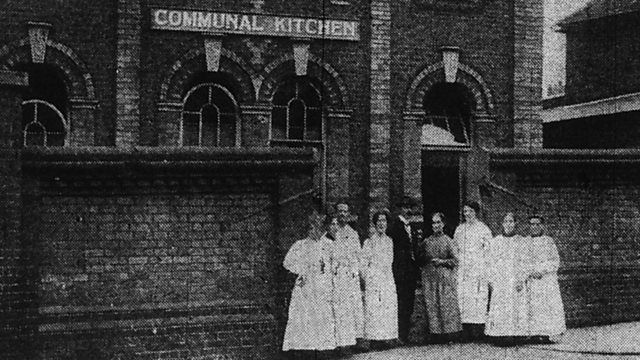Southampton Street, Reading: Model for Feeding the Nation
Communal Kitchen brings fame to Reading as the economic model for how to feed a nation at war
The first Communal Kitchens were started in 1917, as certain food products – including meat – became increasingly difficult to obtain.
Reading became renowned as a model kitchen, following the publication of a pamphlet, which was the first attempt to show how to run a kitchen.
It included details of equipment, staff and finances and prompted visits to Reading from across the country to see the kitchen in action and adopt ideas, with applications for the pamphlet from overseas, including America.
Reading’s first Communal Kitchen opened at the Old British School, Southampton Street on 3 September 1917. It was set up by the Education Committee and run by the Meals Superintendent, Fred Marsh, who wrote the pamphlet.
It was, in effect, a takeaway service open from 11.30am to 2pm every day, except Sundays. Customers could purchase tickets for food cooked at the kitchen and they brought their own basins or plates to carry the food home in.
A typical menu included soup, roast beef or mutton, fried fish, potatoes, onions or cabbage and puddings such as blancmange and jam, rice pudding or apple dumplings. The one item that proved so popular that it was included daily was beef steak pudding.
Newspapers reported that people were so anxious to secure food that they booked their orders and left basins at the kitchen first thing in the morning, returning later to collect the food. Within the first few weeks up to 850 people from all sectors of society were using the kitchen daily and it had already paid its way by the second morning. Two further kitchens were opened in Orts Road and Tudor Road.
Mr Marsh engaged staff to run the kitchen, rather than relying on voluntary help, and they were provided with a uniform of sage green overalls, with white collars, caps and sleeves.
Lady Ellen Askwith from the Central Committee on Women’s Employment was a keen supporter of the Communal Kitchen and wrote the foreword to the pamphlet, in which she refuted the key objections that it would undermine the influence of the home, leave women with too much time on their hands if they didn’t cook, and that they would never learn or else forget how to cook.
A message from Lady Askwith’s husband, when she opened Reading’s second Communal Kitchen in Orts Road, said: “What Reading had done in relation to food education and housing was one of the best examples in the country.”
Elsewhere newspapers published menus and dietary advice, and Heelas of Reading organised cookery demonstrations and a lecture by well known Olympic athlete and Restaurateur, Eustace Miles to encourage the take up of ‘Meatless Cookery’.
Location: Reading’s Communal Kitchen, Southampton Street, Reading RG1 2QZ
Image: Reading’s Communal Kitchen courtesy of Reading Library
Duration:
This clip is from
Featured in...
![]()
�������� Radio Berkshire—World War One At ��������
Places in Berkshire that tell a story of World War One
More clips from World War One At ��������
-
![]()
The loss of HMY Iolaire
Duration: 18:52
-
![]()
Scotland, Slamannan and the Argylls
Duration: 07:55
-
![]()
Scotland Museum of Edinburgh mourning dress
Duration: 06:17
-
![]()
Scotland Montrose 'GI Brides'
Duration: 06:41







